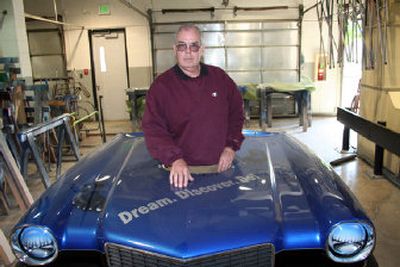Learning from a master

If only everyone had the passion for his job that is apparent from a conversation with Butch Reilly.
Then, maybe this country would glide along as smoothly as the bearings and cylinders Reilly helps students learn about in his Spokane Community College automotive machinist program.
Reilly is no brand new model. He just completed his 31st year of teaching at SCC.
According to the program’s Web site – www.scc.spokane.edu/?auto – after a two-year stay with Reilly, graduates are able to enter the automotive machinist field as skilled workers.
Reilly enthusiastically has been imparting decades of hands-on experience to his students.
“We’re all in love with the car,” said Reilly, 59, who grew up in Spokane, going to the Deer Park drag strip and watching an untold number of innovators at work there in the pits.
“I can remember going to Deer Park with Junior Bennett, Larry Armitage in 1958-59,” Reilly said. “They had the first car where the engine was behind the driver. They’re all that way today.
“Going up to Deer Park, I just thought it was the greatest thing in the world.”
Reilly got his start in the SCC auto tech program. From there, he went to work at Unit Engineering, a machine shop in Spokane.
“They closed, and I bought some of their equipment,” and he went into business for himself.
Reilly started teaching in the summer of 1977.
“The faculty in this building isn’t here just during school hours and that’s it,” Reilly said of his colleagues who team up to teach everything automotive in the complex of shops on the east end of the SCC campus.
Reilly speaks highly of the auto program faculty. “It’s not just our job,” he said. “You can make your job as a teacher as much as you want or as little as you want.
“I think, right now in this building, if it’s auto machinist, auto tech, auto collision, we truly want to be teachers,” Reilly said. “We want to convey – and we do.
“Right now, the door’s wide open for a talented, smart kid, whatever part of the building they get involved with,” Reilly continued.
“I have these guys for two years, and they have me for two years. That can be good or bad,” he said with a laugh.
There are the stereotypical students – the gear guys – who enroll in Reilly’s program. And then there’s Ryan Naccarato, the incoming SCC student body president. He will be the second student body president from Reilly’s program.
“To tell you the truth, I was actually placed in this program by accident,” Naccarato said. “They put me in this program, and (I) quickly realized this is where I wanted to be.
“It was a good mistake,” said Naccarato, who, after another year with Reilly, plans to move on to the diesel/heavy equipment program.
“Then after that, maybe Gonzaga or Eastern (Washington University) in mechanical engineering,” he said. “From there, I want to go to Stanford, but we’ll see.”
Only 12 to 15 similar automotive programs exist in the country, according to Reilly. “There are a lot of auto tech programs but not a lot of auto machining programs because of the price of all this equipment.
“We’re well-known throughout the country,” Reilly continued. “Spokane Community College is doing something OK in this field.
“Being a community college, we serve the remanufacturers and jobber machine shops,” he said. Spokane is the nation’s per capita leader in engine rebuilding shops, which means there are adequate placement opportunities for grads.
Beyond Spokane, Reilly said, “if they throw a dart at a map, we can find an interview in that town.”
Having high-profile jobs with major racing teams is the goal for some students. Reilly helps place students with the National Hot Rod Association and NASCAR teams.
“Yeah, they do OK,” Reilly said with more than a hint of pride in his voice.
“Performance work is kind of that carrot in front of these guys,” he said. “They all want to go to work for NHRA, NASCAR. That’s incentive for them. So we will do performance work when a student progresses to that point.”
Of course, students begin work on a more mundane level. An old Pontiac straight-8 was one project in the system, but, Reilly said, “we’ll do anything from late-model (Toyota) Camry engines to that ‘49 Pontiac. Machine work is machine work.”
Under Reilly’s two-year program, students learn how to resurrect an engine from the dead. The SCC shop is full of machines that are familiar maybe only to those who really know the business. Take the submerged arc crank welder, for instance.
Reilly pointed out that the device “can take a crank (shaft) that’s been destroyed through bearing failure or an antique one that’s been reground so many times we can build the journals back up and bring it back to life.” That’s pretty new technology, according to Reilly.
Some of that practice in high performance comes close to home – and, in fact, just down the hall. The automotive programs have banded together to build cars for both circle track and drag racing.
The class “project car” is a 1970s-era (Chevrolet) Camaro that turns 9-second elapsed times on the drag strip at Spokane Raceway Park.
The engine for the “project car” is the perfect high-performance lab experiment. “We can do (the work) here in class in the regular curriculum. It fits what we’re doing here in class,” Reilly said.
Chassis work, however, is done after hours.
A Suburban tow vehicle trailers the car adorned with SCC’s Bigfoot logo to high school career days, to malls and on other outings. “It’s a really neat marketing tool,” Reilly said.
He quickly adds that the car is “not a taxpayer car. It’s a car that was all donated.”
And, Reilly said, “if we show up at career days, the rest of the exhibits might as well go home.”